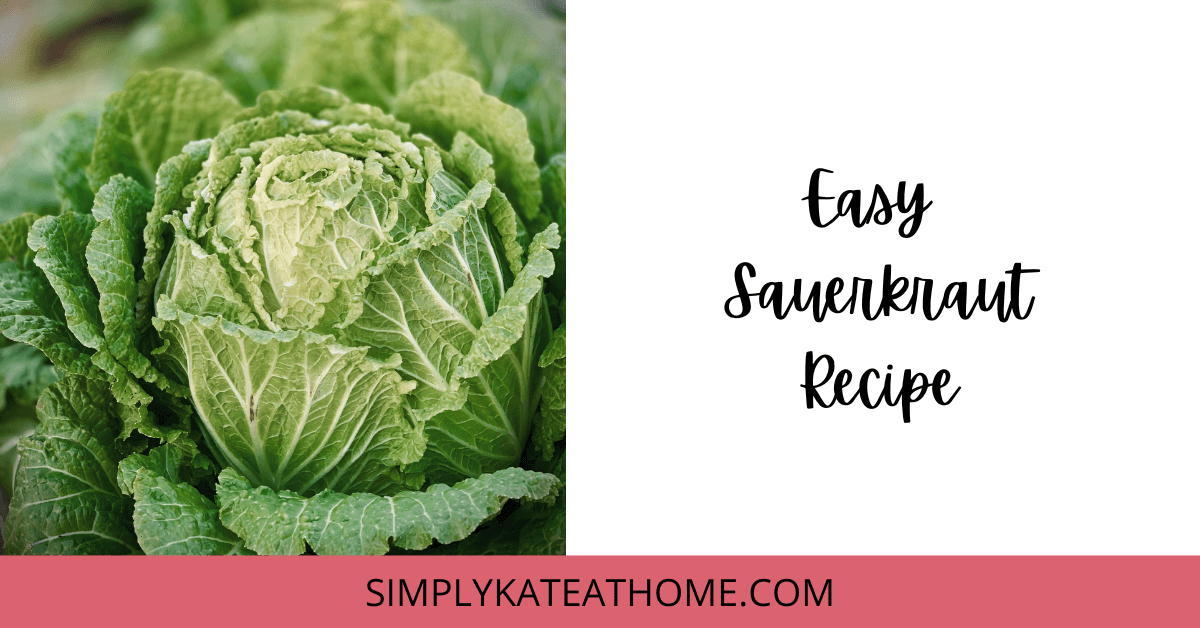Easy Sauerkraut
Easy Sauerkraut: Ready, Set, Snack!
What’s better than an easy sauerkraut recipe? All you need is a head of cabbage, a mason jar, and some salt. By the end of this short blog post, you’ll know how to make your own easy sauerkraut recipe in a jar. Next stop: tasty-town.
I fell in love with fermented foods a long time ago. There’s something so magical about fermenting things… chop up some veg, put it in a jar with some salt, wait a while, and you’re done. It takes simple vegetables and creates this tangy, crunchy, elegantly elevated vegetable that I just can’t get enough of.
Curious about other things you can stuff in a jar and ferment? Check out this fire cider recipe.
What is Sauerkraut?
Sauerkraut is a traditional dish made from fermented cabbage. It is a staple in many cuisines, particularly in Germany and Eastern Europe. The process of making sauerkraut involves slicing or shredding cabbage and mixing it with salt. The salt helps to draw out the cabbage’s liquid, creating a brine that covers the cabbage and protects it from harmful bacteria during the fermentation process. The mixture is then left to ferment for several days to several weeks, until the desired level of tanginess is achieved.
Sauerkraut is rich in probiotics, which are beneficial bacteria that aid in digestive health. It is also high in vitamins C and K, fiber, and antioxidants. Sauerkraut is often used as a condiment, but can also be used in a variety of dishes, including soups, stews, and sandwiches.
In addition to its health benefits and versatility, sauerkraut is also known for its distinctive sour taste, which is the result of the lactic acid produced by the fermentation process.
Sauerkraut has two simple ingredients: salt and shredded cabbage. There are a dozen different variations of sauerkraut, each with its own traditions behind it.
From Hawaii, you’ll find pineapple sauerkraut. Traditional German sauerkraut can include juniper berries. Kimchi is similar to sauerkraut and is a popular Korean food.
The options are seriously endless.
How to Make Sauerkraut
I promise, it’s super duper easy!
Here’s what you’ll need:
- One head of cabbage (homegrown in your organic raised bed garden could be fun, too)
- Salt (I like pickling salt or Redmond’s)
- Wide-mouthed mason jar
- Lid
- Sharp knife
- Large bowl
Optional
- Pickle pipe from Masontops
- Pickle weight from Masontops
- Pickle packer from Masontops
When I started making sauerkraut, I didn’t want to invest in the “fancy” tools until I knew what I was doing. Honestly, I still prefer it with limited gadgets–I don’t want single-use tools in my kitchen taking up space.
Alright, on to the important part: the steps to make sauerkraut!
Steps to Make Homemade Sauerkraut
- Slice the cabbage in half, and cut out the core.
- Using your knife, slice cabbage thinly–it doesn’t need to be pretty!
- Transfer to a bowl, and salt ~generously~. You want it to taste like ocean water. A good rule of thumb is about 2% of the weight of the cabbage in salt.
- Mix the shredded cabbage with salt and crunch it with your hands or a pickle packer. This helps break down the cabbage to release the liquids. It takes about 10-15 minutes.
- Pack the salted cabbage tightly into a sterilized jar, using your hands or a cabbage tamper to remove any air pockets. Make sure the liquid covers the cabbage completely. If you’re short on liquid, create a 2% brine to top it off.
- Cover the jar with a clean cloth and secure it with a rubber band. Place the jar in a cool, dark place (60-70°F) and let it ferment for at least 7 days. I also really like using a pickle pipe from Masontops for this!
- Check the sauerkraut daily and remove any scum that may form on the surface.
- Taste the sauerkraut after 7 days and continue fermenting until it reaches your desired level of tanginess. This can take anywhere from 7 to 21 days, depending on the temperature and your personal preference.
- Once the sauerkraut is ready, transfer it to a clean jar and store it in the refrigerator for up to 6 months.
It doesn’t last long in my house. Try your best not to eat it all at once!
Will you try this fabulous fermentation? Let me know in the comments!







